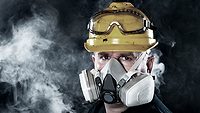How Restorers Can Protect Against Blood Borne Pathogens — Part 2

Photo: alexstockphoto21/iStock / Getty Images Plus via Getty Images
In last month’s Part 1 article on BBP hazards in the restoration industry, I covered the following:
- Basic procedures and practices that allow us to perform many different services
- BBP exposure scenarios for Restoration Technicians
- Common pathogens and OPIM’s
- How pathogens get into the body
- Preventing pathogen entry into the body
Let’s expand on our knowledge and jump right into the topics for Part 2!
OSHA Expectations
In OSHA’s 1910.130 BBP Standard, they immediately identify the requirement for an Exposure Control Plan if employees have exposure to BBP’s. (1) These plans are “…designed to eliminate or minimize employee exposure.” OSHA provides details on the elements of the plan, but I recommend finding a resource that provides a plan outline for you to follow and create your Company-Specific Plan. I have found that some States provide excellent outlines to be used as a starting point.
Other parts of the OSHA BBP Standard include:
- Universal precautions
- Engineering and work practice controls
- PPE
- Regulated waste
- Housekeeping
- Vaccinations
I will expand on a few of these topics; however, covering them in-depth would literally fill up this magazine issue and possibly more. Instead, let’s cover a few key topics that will ultimately lead you to addressing all the OSHA BBP topics.
Universal Precautions
I would be remiss if I discussed exposure to BBP’s without mentioning Universal Precautions, which should be….well….used universally. Simply stated, treat any materials (bandages, body fluids, medical equipment) that could have BBP’s as if they actually do have BBPs. That means protecting yourself from them, handling them appropriately, cleaning/sanitizing after removal, and proper containerizing and disposal.
Training
I mentioned procedures, controls, and practices. For the topics of BBPs and biohazards, understanding the industry standards and getting trained on them will provide huge value to your restoration work. OSHA specifically lists out training requirements. (2) If you have previous experience, knowledge, and time to develop the training you could train your own employees. However, that’s not always the most efficient route.
In terms of understanding industry standards, that would be the IICRC’s S540 Standard for Trauma and Crime Scene Cleanup. (3) Having a copy of this on hand will provide you with an immediate and long- term source of information.
High quality training on this work is extremely valuable and “gets you in the game” quickly and safely. For instance, you can attain the IICRC’s Trauma and Crime Scene Technician (TCST) certification. (4)
PPE
Protection from BBPs is going to vary by the situation. For instance, the application of first aid to a co-worker will likely require basic hand and eye protection. However, if a technician is going to perform a crime scene cleanup, PPE requirements would expand to protection of the shoes, clothes, skin, eyes, and even face. I strongly recommend using the S540 Standard and training/certification to help understand the correct protective measures. Then, make sure those measures are included in the Job Hazard Analysis for each job!
Vaccines
I often say that OSHA rarely crosses over to regulating or requiring the “health side” of EHS, such as vaccines and inoculations. However, this is a specific instance where OSHA requires employers to offer the Hepatitis B vaccine to any employee exposed to BBPs. More specifically, it is to be offered after training and within 10 working days of initial work assignment. (6) Check out the OSHA Fact Sheet, Hepatitis B Vaccination Protection, for more information. (7) As many of you know, not everyone is a fan of vaccines. In this case, OSHA has provided a form to complete for an employee to decline the vaccine.(8) I believe that OSHA made the right choice in providing an option to decline; however, I would recommend to be sure that anyone who declines the vaccine completely understands Hepatitis B and the health implications.

Putting It All Into Practice
Now I’d like to briefly lay out some scenarios where a restoration company can put its knowledge, training, and preparation work into practice. Here are three most common scenarios that I feel a restoration technician might experience. All three end up being very technically similar from an exposure standpoint, but the situations are different. The scenarios are:
- An injury or accident
- BBP’s encountered at a jobsite
- Biohazard/trauma/crime scene cleanup
- Injury/accident exposure
This exposure can occur at any work location, such as the office, warehouse, parking lot, or jobsite. Most commonly, an employee or contractor is injured and is bleeding. Other trained employees may render first aid or clean up blood and bandages. Again, from an exposure viewpoint, the hazards relate directly back to our training and OSHA requirements………use universal precautions, protect yourself from entry into your body, and clean/collect/dispose of the materials so that others aren’t exposed.
BBPs Encountered at a Jobsite
This exposure may be an unexpected discovery, such as a syringe or bloody bandage found in a building while performing water extraction or carpet removal. However, there are buildings where you could expect to encounter a syringe, bloody bandage, or scalpel; such as a medical clinic, doctor’s office, or hospital where you are performing emergency services. Your precautions and practices would be the same as the first scenario, with the likely addition of handling/disposal of sharps and a larger volume of biohazard waste.
Biohazard/Trauma/Crime Scene Cleanup
Ultimately, I feel this scenario gives restorers a chance to practice everything you learned and make a profit doing so! Here we are intentionally encountering the hazards in order to clean/sanitize, containerize, and dispose of the hazards so that the area may be safely re-inhabited. We are secondary responders to the scene (i.e. police and/or EMS have already performed their work).
This work is not for everyone and techs could see the results of trauma or crime that could be disturbing to them. This needs to be taken into consideration before performing these types of cleanups. However, looking at it from a pure exposure standpoint we have the same hazards as previously mentioned. Granted, the exposure will be a longer duration with likely more hazardous materials. However, that simply means techs will need to continue their vigilance of following the best precautions and practices.

References and Resources:
- 29 CFR 1910.1030 (c) Exposure Control. https://www.osha.gov/laws-regs/regulations/standardnumber/1910/1910.1030
- 29 CFR 1910.1030 (g)(2) Information and Training. https://www.osha.gov/laws-regs/regulations/standardnumber/1910/1910.1030
- Institute of Inspection Cleaning and Restoration Certification, ANSI/IICRC S540 Standard for Trauma and Crime Scene Cleanup. https://iicrc.org/s540/
- Institute of Inspection Cleaning and Restoration Certification, Trauma and Crime Scene Technician (TCST). https://iicrc.org/tcst/
- Microbial Warrior Academy. https://www.microbialwarrior.com/
- 29 CFR 1910.1030 (f) Hepatitis B vaccination and post-exposure evaluation and follow-up. https://www.osha.gov/laws-regs/regulations/standardnumber/1910/1910.1030
- Occupational Safety and Health Administration, OSHA Fact Sheet, Hepatitis B Vaccination Protection, DSG 1/2011. https://www.osha.gov/sites/default/files/publications/bbfact05.pdf
- 29 CFR 1910.1030 Appendix A Hepatitis B Vaccine Declination (Mandatory). https://www.osha.gov/laws-regs/regulations/standardnumber/1910/1910.1030
Looking for a reprint of this article?
From high-res PDFs to custom plaques, order your copy today!






